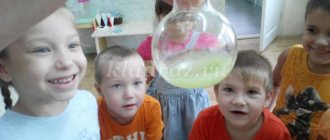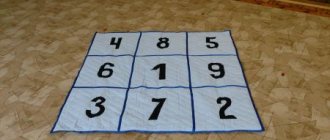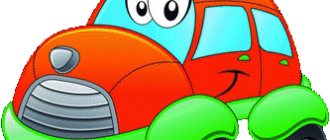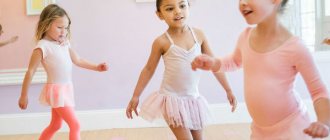Organization of surveillance
To organize observation, you need to properly prepare the process:
- Choose a plant or animal that looks healthy.
- The place must be clean and consistent with natural conditions.
- The chosen place should be well lit, it is better if the light falls slightly from the side.
- Children need to be positioned so that none of them interfere with each other or block the view.
- If possible, each child should touch a plant or pet an animal.
Convenient placement of children around the object being studied
Approximate plan for a walk-observation
The process of reviewing and discussing an object should comply with the following recommendations:
- Children need about 2 minutes to make their first impression. During this time, the children will have time to examine the object and satisfy their curiosity.
- The teacher should talk about the object in 1 minute.
- Next, children’s thoughts need to be directed in the right direction. If necessary, read a poem or ask a riddle. This is how the children form an emotional attitude towards the object. The time should not exceed 7 minutes.
- Afterwards, the object is examined in detail. The teacher asks leading questions and helps with answers. Provides missing information. This will take no more than 10 minutes.
- At the end, a summary is summed up and all the knowledge gained is connected with each other. This process takes about 5 minutes.
Additional Information! The teacher can start a colorful observation diary together with the children.
Children's research activities during a spring walk
Research activity involves the child’s independent search for information.
Organization
You can organize the process in the following ways:
- Children, while answering questions about the object in question, try to correctly express their own thoughts.
- When observing an object for a long time, the guys notice all the changes and, if necessary, record them.
- When observing living or inanimate nature, additional items are used: dark glasses, gardening tools.
- During an excursion, when they go to the city, to a library, a food factory, or when observing construction work, production technology or the process of organizing services is studied.
- After visiting the museum, a more detailed study occurs by looking at the encyclopedia or other materials.
You can also organize experiments under the close supervision of a teacher.
"Research activities in the middle group"
CARD FILE OF EXPERIENCES WITH MIDDLE PRESCHOOL CHILDREN
Experiments with water
Experience No. 1
Topic.
“How does water reflect objects?” Target.
Reveal with children the property of water to reflect various objects. Develop fine motor skills and the ability to establish logical connections. Maintain a desire to maintain a neat appearance. Equipment. Mirror, bowl of water, doll in a dress. Move. Kuzya comes to visit the guys with a dirty face. The adult invites the children to look for changes in the appearance of the brownie Kuzya: “Guys, what happened to Kuzya? How can I help him? What item helps us take care of our appearance? (Mirror). How does water help? Educator: “Water washes away dirt. Water also has the properties of a mirror. Let's play with water. What kind of water? (Transparent, clean). Let Vanya lean over the basin a little and look at the water. What can you see in a bowl of water? (Your reflection). What does it look like? (On a dark spot). If Vanya moves to the side, how will the reflection change? (The reflection will move in the water.) Why do we see our reflection in water? (The water is clear). Game exercise “Break the mirror”. Questions: “You threw pebbles into the water. What happened to the water? (The reflection has disappeared.) When can you see your reflection again? When the circles from the object disperse, the water will become calm and you can again see the Game “Show the fairy-tale animal” - with the help of finger movements, children come up with various figures and find them through the reflection in the water. Conclusion. “Water, like a mirror, reflects objects in itself.” Experience No. 2 Topic.
“How to push the water out?” Target.
Form the idea that the water level rises if objects are immersed in water. Develop thought processes, fine motor skills, activate vocabulary (edge, rises, falls, higher, lower). Maintain a positive attitude towards your work and the work of your colleagues. Equipment. Measuring container with water, pebbles, spoons. Move. Brownie Kuzya comes to the guys in a sad mood: “I’m sad because I have no toys at all; only pebbles. How to play with them? Educator: “Let's cheer up Kuzya with a new game. For this game you only need water and pebbles.” Questions: “How much water did I pour into the jar? Is the jar completely filled with water? (No, the jar is half full). How to make the water reach the edges of the jar? (children's answers). The teacher suggests putting pebbles of different sizes into the jar. Questions: “What happens to the water?” (She gets up). Why does the water rise? (Because we put pebbles in the water). Game exercise “Catch the pebbles” - children remove pebbles from a jar using spoons. Conclusion. “Water in a container rises when objects are immersed in it.” Experience No. 3 Topic.
“How to color water?” Target.
To form children's ideas about the dependence of the color intensity of water on the amount of food coloring. Develop the ability to distinguish between dark and light shades and establish cause-and-effect relationships. Promote the manifestation of a humane attitude towards the game character. Equipment. Food colors of different shades, transparent cups, measuring spoons, a container with water, colored paper squares. Move. Brownie Kuzya turns to the children asking for help: “Guys, in the summer I saw a very beautiful rainbow. And I wanted to draw it. The only problem is that I don’t know any flowers. Maybe you can teach me to distinguish and correctly name color shades? Educator: “Of course, Kuzya, the guys won’t leave you in trouble. And the magician water will help us again. Let's tell Kuza how you can get different shades using water (children's answers). Water takes on the color of the paint dissolved in it. Today we will color water and create color shades using food coloring. Food coloring is similar to colored sand and is used to give foods a specific color. For example, they paint eggs for Easter. Inspection activities: “In one glass of water I will put one spoon of red dye, in another glass of water I will put two spoons of red dye. What happened to the dye in the water? (It dissolves in water). What happened to the water? What color is the water in both cups? (In red). Are the colors of water in the glasses the same or different? (Different). Why? In which glass is the water lighter and in which is it darker? In a glass with more dye, the water is darker. In a glass with less dye, the water is lighter.” Game tasks: “Choose a square on the tray, turn it over and find out the color. The water should be dyed this color. Remember how many spoons of dye you put in the water.” Questions: “What color did you color the water? How many spoons of dye did you put in?” Game task: “Make the shade lighter (darker).” Educator: “Let’s tell Kuza what colors we painted the water.” Conclusion. “Water can be colored with food coloring. The more dye, the brighter the color of the water.” Experience No. 4 Topic.
“How do plants drink water?” Target.
To form children's ideas about the process of water movement through a flower. Develop curiosity and thought processes. Promote caring behavior towards plants. Equipment. Flowers - white carnations, transparent cups for water, three colors of paint, a container with water, colored pencils, white paper with sketches of cups. Move. Part 1 - preparatory. Brownie Kuzya brings a withered flower with dry soil to the group. “Guys, I planted a flower in a pot. I put it in the sun. Every day I admired him and talked to him. But my flower has withered. I can’t understand what he didn’t like?” Educator: “Why did Kuzya’s flower wilt? How did you guess? Flowers need constant watering. Based on the condition of the soil, you can determine whether to water the plant or not.” Kuzya: “How does a plant drink water?” Educator: “To find out how a plant drinks water, you need to prepare multi-colored water. What color is the water? (The water is clear). How to make colored water from clear water? (Dilute paint in water). Three cups will contain colored water and one cup will contain uncolored water. We will put a flower in each glass. What is the name of the flower? (Carnation). What color is it? (White)." Sketch of observations: “Paint the cups on paper with the same colors as we colored the water - red, blue, yellow); Do not paint over one glass - the water in it is clear. In each glass, draw a flower with white petals. A little time will pass and we will see flowers drinking water.” Part 2. In the evening, look at the colors of flowers with the children. “Compare your sketches with the observed phenomenon. What changed? What happened to the flowers? What did the flowers become? Why are flowers different colors? Why did one flower remain white? Explanation: “The flowers changed their color due to the color of the water in which they stood. The stem has conducting tubes through which water rises to the flower and colors it.” Conclusion. “Flowers drink water; water moves through the flower.” Experience No. 5 Topic.
“We determine the temperature of the water.” Target. Identify with children ways to change water temperature. To contribute to the expansion of ideas about the life of natural objects in the water element. Activate children's vocabulary (geyser, steam, temperature, algae), develop curiosity and thinking. Maintain an interest in the natural world. Equipment. A ball, empty cups with hot and cold water, pieces of ice, illustrations of rivers, lakes, seas, geysers. Move. Brownie Kuzya invites the children to play the game “Cold, Warm, Hot.” Educator: “If I throw you a ball and say “cold ball,” you must name an object that is always cold. In response to the phrase “hot ball,” you need to name objects that are hot.” Kuzya: “Guys, what can be cold, hot, and warm? (children's answers). Let's play with water today and find out how water changes its temperature." Game task “Determine the temperature of the water.” Educator: “Water can have different temperatures and can be hot, warm and cold. How do you know which glass is cold and which is hot? (You need to touch the glass or water with your hands.) How to get warm water? Let's mix hot and cold water. What did the water become? (Warm). Now put ice cubes in warm water. What do you think the water will be like? Touch the water with your hands. Why did the water become cold? (Ice was added to the water, it is cold).” Examination of illustrations: “In rivers, lakes, seas, water is of different temperatures - warm and cold. Some animals, fish and plants live only in warm water, others only in cold water. There are places in nature where hot water comes out of the ground. They are called geysers. Steam comes from them. Only algae live in geysers.” Conclusion. “Water can be warm, cold and hot. When you pour different water, its temperature changes.”
Card file of observations for walks in the preparatory group. Spring
The preparatory group is attended by children of senior preschool age - 6-7 years old. For a child, this period is considered responsible. It is designed to prepare children for school. The teacher’s task is to create conditions for learning and conduct classes that will prepare the child intellectually, morally and physically for school. And also quickly adapt and socialize in first grade.
Children on a walk
The teacher of the preparatory group selects materials and prepares notes for intellectual and entertaining classes in accordance with the Federal State Educational Standard. Children learn better and remember new material faster if it is presented in an interesting and playful way.
When teaching children to observe the surrounding nature, the cognitive process should be gradual. Children should see how nature changes month by month and analyze each change together with the teacher.
This complex process involves the child's cognitive functions, such as:
- speech;
- thinking;
- attention;
- auditory, visual and tactile perception.
By the end of the preparatory group, the children receive basic knowledge about living and inanimate nature and understand the role of humans in it.
Observation of living and inanimate nature
Purpose: to give an idea of spring and the change of year.
Studying icicles up close
Observation March preparatory group: Go out with the children for a walk, preferably on a sunny day. Tell that March is the first month of spring. The sun gets warmer and the snow begins to melt. It gradually turns into water, which is absorbed into the soil. The plants drink it and their growth begins. The first grass appears, and leaves grow on the trees and buds swell.
Tell a rhyme:
Spring has arrived. In the spring, the buds swelled and the leaves hatched. Look at the maple branches - How many green noses there are! Author: T. Dmitriev
Additional Information. Show the children icicles and explain how they appear. Offer to place a bucket under the dripping icicles. Let the children observe how much water collects. Then, water the plants with this water.
Watch the snow melt. Let the guys take shovels and clear the paths. The snow will be placed in the sun and in the shade. They will observe where it melts faster. The teacher must explain why this happens.
Read S. Marshak’s poem “March”: The loose snow darkens in March, the ice on the window melts.
Observe the operation of a snowblower. Explain that she takes the snow to the fields where it melts. Tell why they do this. Invite the children to play: whoever removes the snow faster will jump further up from their spot.
Talk about animals. In spring, migratory birds arrive and wild animals, such as bears, emerge from hibernation. Later, when it gets warm, the birds will begin to build nests and have chicks. The animals will have offspring. In the group, show pictures of who has which animals.
Observations in March in the preparatory group are of an introductory nature.
Bird watching in spring
Purpose: to show the life and behavior of birds in spring.
Building a bird feeder in early spring
Observations:
- In the yard the children can see sparrows, tits, pigeons and rooks. The teacher says that birds select a mate, build nests and lay eggs. One bird hatches them, and the other carries the worms for food, because the eggs cannot be left behind. Explain why.
- Children listen to birdsong. Together with the teacher, they hang up the feeder and put food in it. Explain what birds eat.
- Explain what hatched chicks eat and how they learn to fly. Until November, migratory birds fly to warm countries for the winter.
- The teacher asks questions about the material covered.
- Invite the children to clean up the area. Divide them into groups and monitor their joint work.
- Play: let the children be birds and run away from the teacher. Take the ball and ask them to hit the target, so the guys will develop their eye and strength.
Environmental education classes for preschoolers
Weather observation
Goal: develop observation skills.
Observations:
- Children notice changes in the environment every day: the snow around is melting, the sun is getting warmer every day, the sky is clearing. The clouds become lighter and blue skies are visible more often. Explain how clouds form. In May the sky turns bluish.
- In early spring there is frequent rain and hail. Tell where they come from and why. There is a temperature difference - the higher, the colder. There, the steam that rises from the water on the ground turns into ice. Rain often comes with hail.
Ask a riddle:
Fluffy cotton wool: Floating somewhere. The lower the cotton wool, the closer the rain. (Cloud)
Additional Information! Invite children to sprinkle sand on the paths. Remove trimmed branches from trees and bushes.
Watching the sun
Goal: Find out how the sun affects plants, animals and humans.
Observations:
- Tell that with each spring day the sun gets higher and the days get longer. It rises from the east and sets in the west. Show cardinal directions. The sun's rays hit the plants and because of this, their growth occurs. For good health and well-being, you need to be in the sun as often as possible.
- Invite the children to touch the stones. Those on which the sun's rays fall become warm because they heat up. And the stones in the shade remain cold.
- Explain that planets revolve around the sun.
- Play: the teacher is the sun, and the children are the planet. They walk around and then run away. The teacher catches them.
Additional Information! Bring sunglasses with dark lenses. Tell them that they protect the eyes from bright rays.
Birch tree observation
Goal: to develop knowledge about birch.
Birch tree observation
Observations:
- Show tree. Let the children remember what it looks like.
- Tell that the birch tree has roots. They are strong and go deep into the ground. Roots are needed for the tree to stand strong in the wind. Birch, with the help of its roots, consumes moisture and nutrition from the ground. In the roots they turn into juice, which rises first up the trunk, then into branches and leaves. If you make a hole, it will flow and you can drink it. In April, birds make nests on birch trees, insects land and caterpillars crawl, which then turn into butterflies. In winter, in February, hares eat the bark because there is little food for them at this time. Tell that in autumn the leaves on the tree turn yellow and fly off.
- Offer children a game where they will list all the trees they know.
- Let the children collect fallen branches from the area.
- They will learn to walk in formation.
Soil monitoring
Goal: find out information about the land.
Observations:
- Let the guys observe in which place the earth dries out faster. Explain why this depends on sandy soil more quickly than on clayey soil. Sandy soil is looser, it absorbs water faster and lets it pass through it deeper. Clay is more dense, so the process of moisture absorption occurs more slowly and in early spring this takes about a week. Let the children note that plants grow better and faster in sandy soil.
- Invite the children to dig up different soils and compare them themselves. See that there are small roots, sticks and leaves in the ground. Let them take a watering can and water the soil one by one, and see which one dries out faster.
- Give the children the task of bringing fresh soil under some tree roots.
- Play jump rope, exercises with which strengthen muscles and develop coordination of movements.
Thematic planning in the preparatory group on the theme “Spring”







